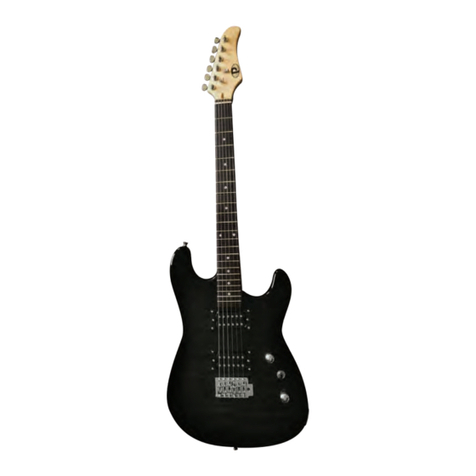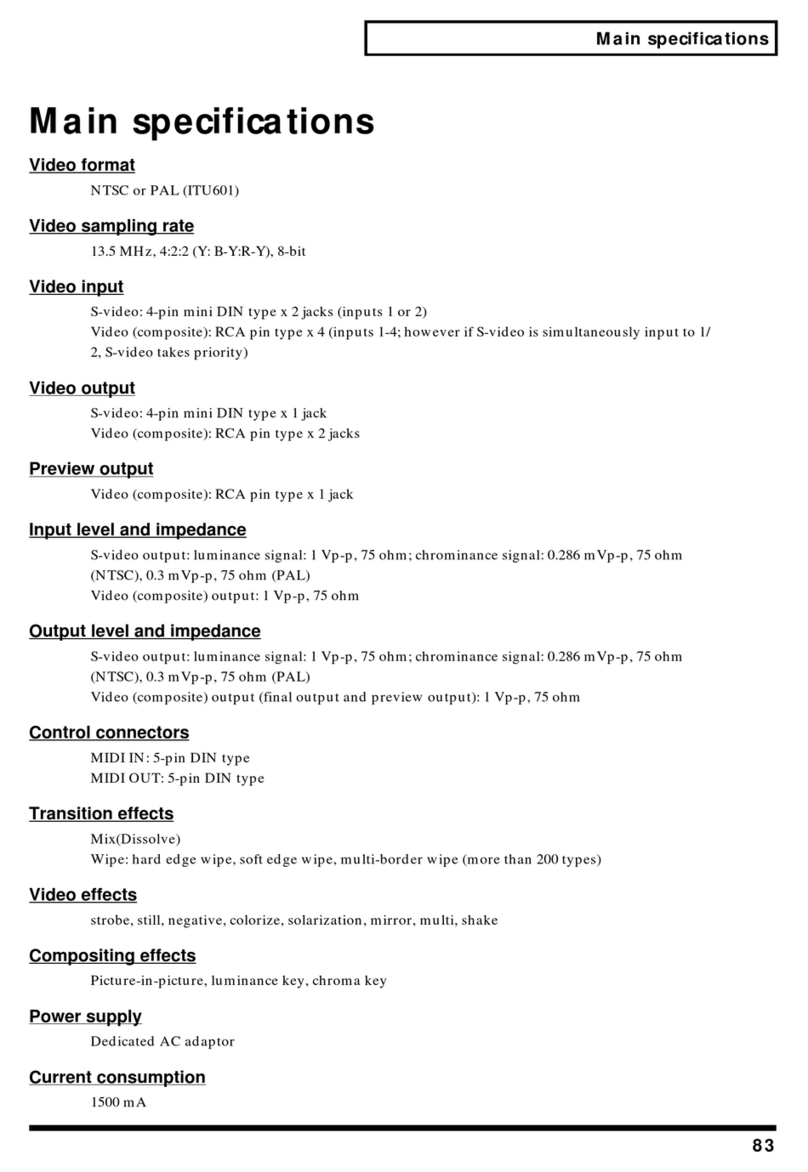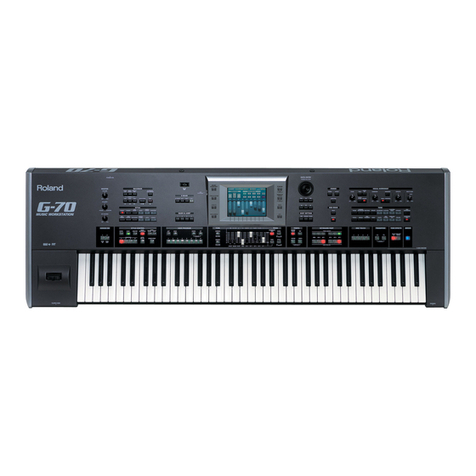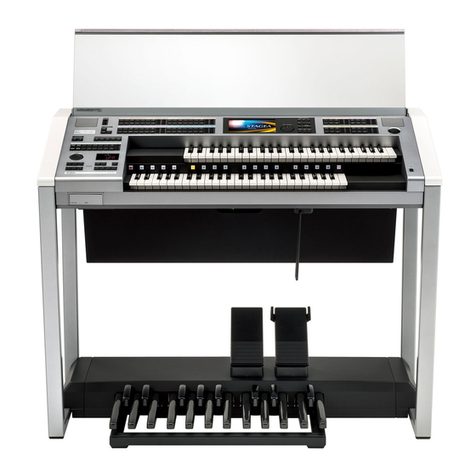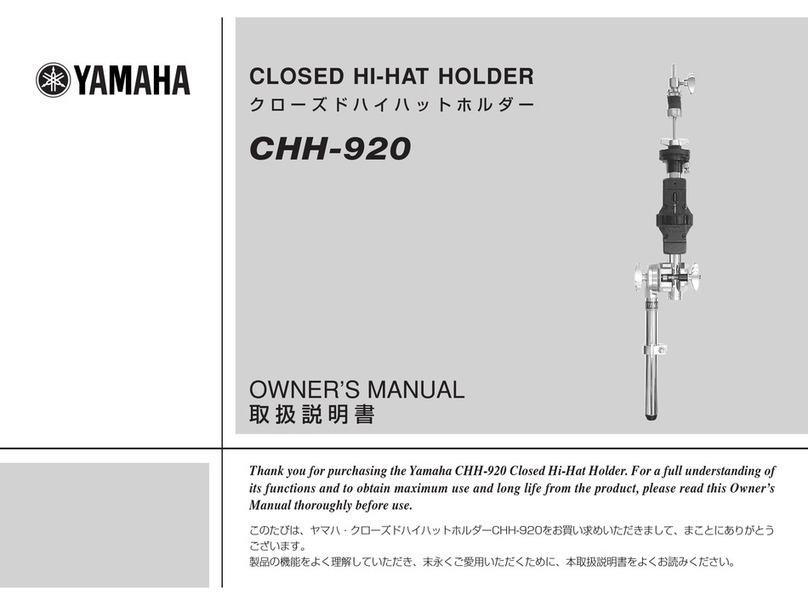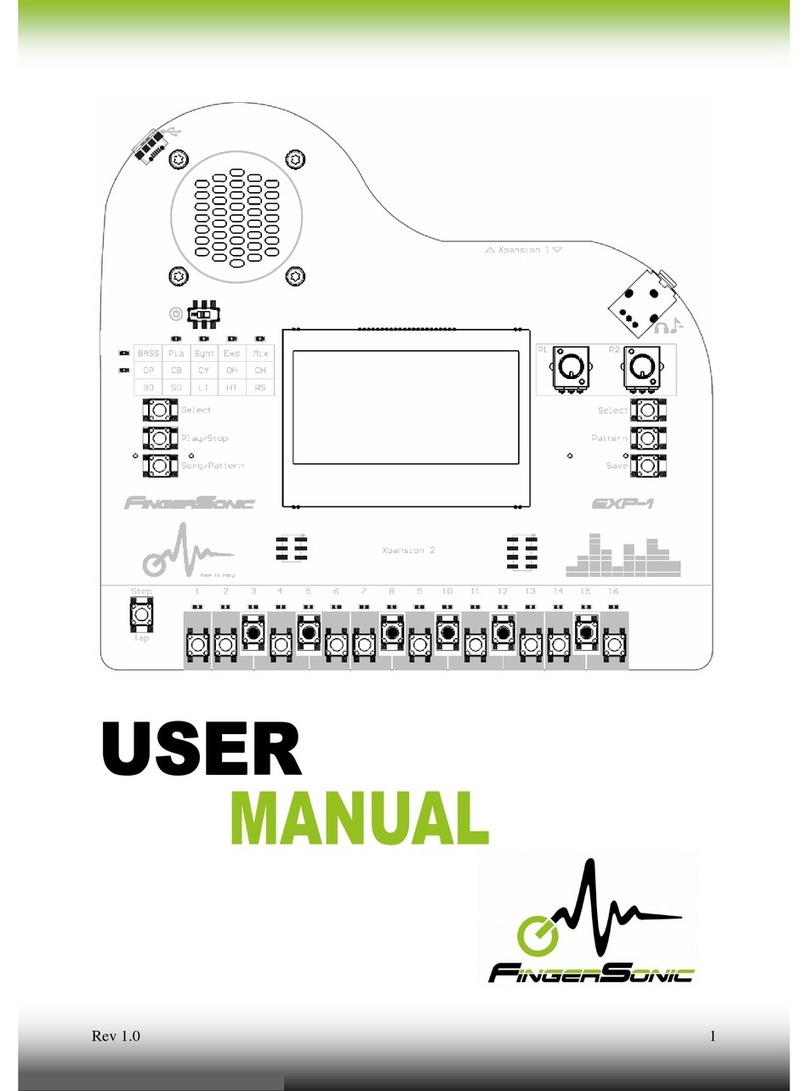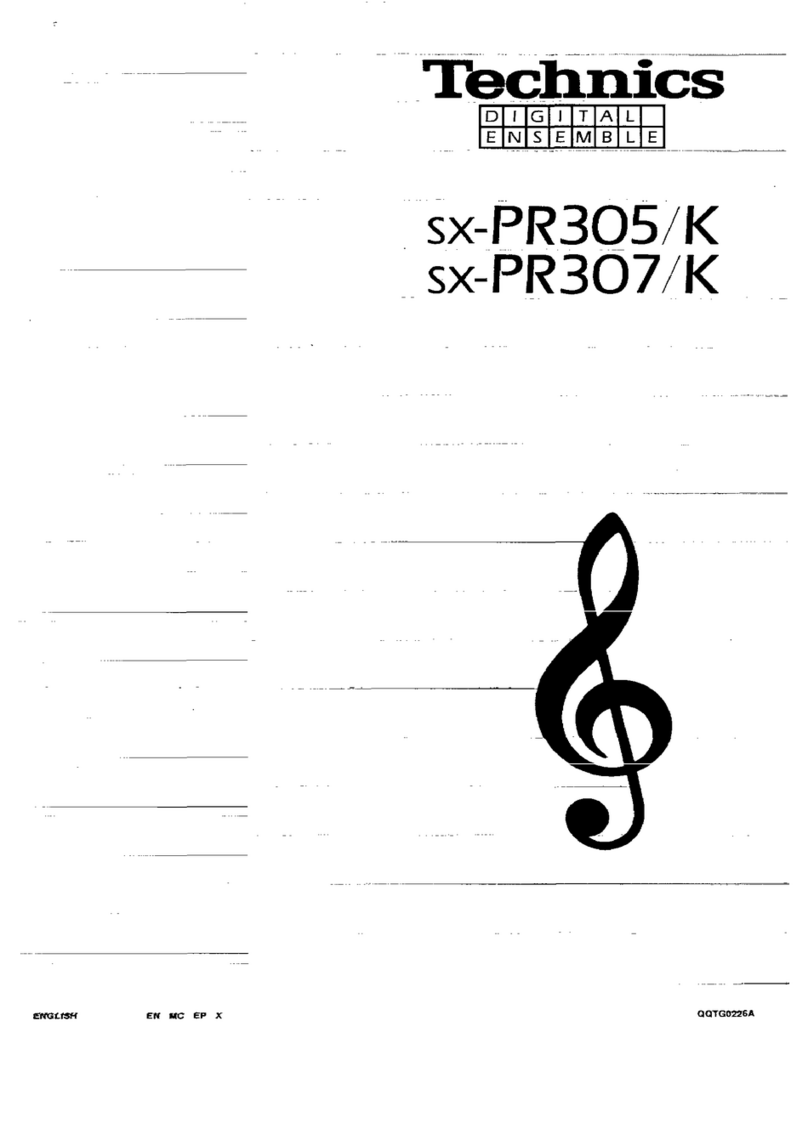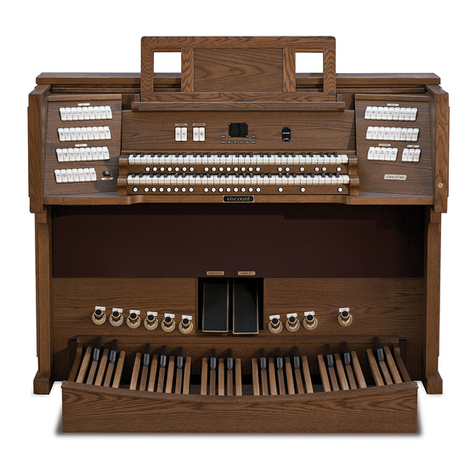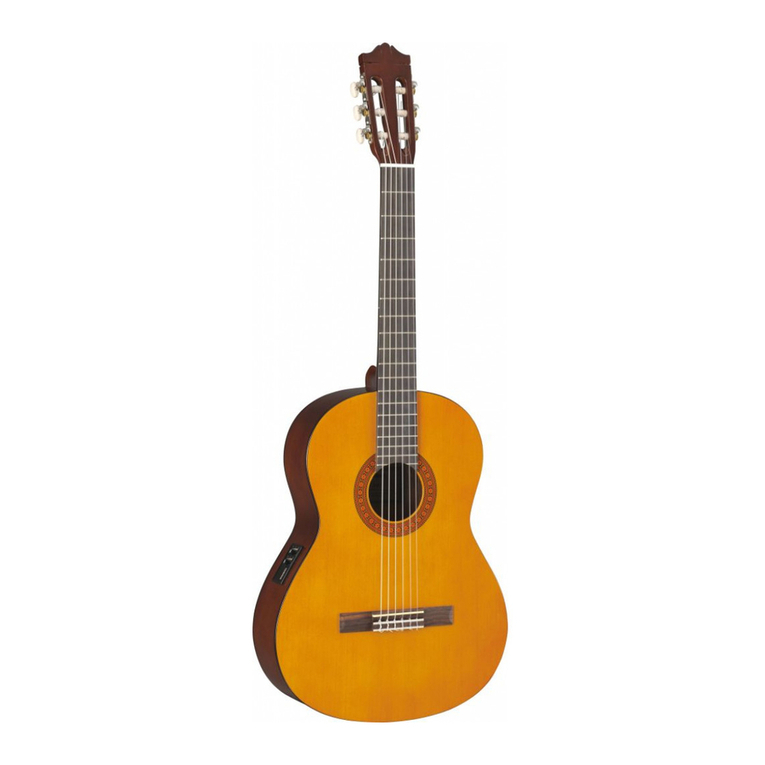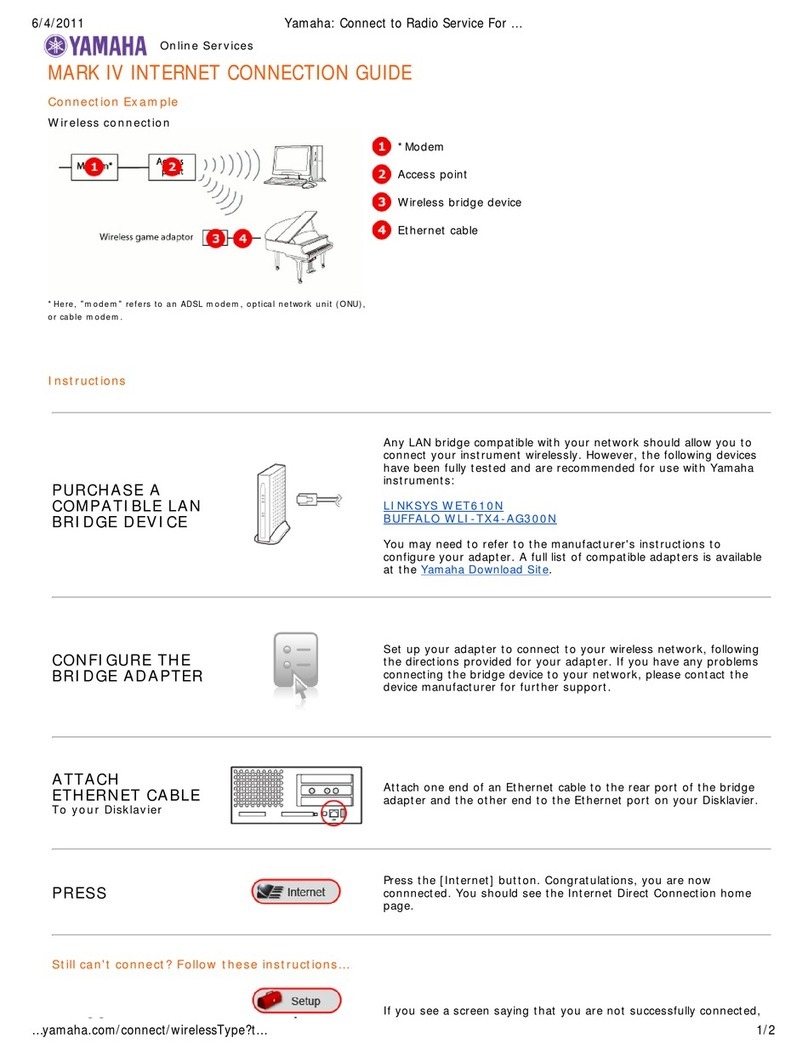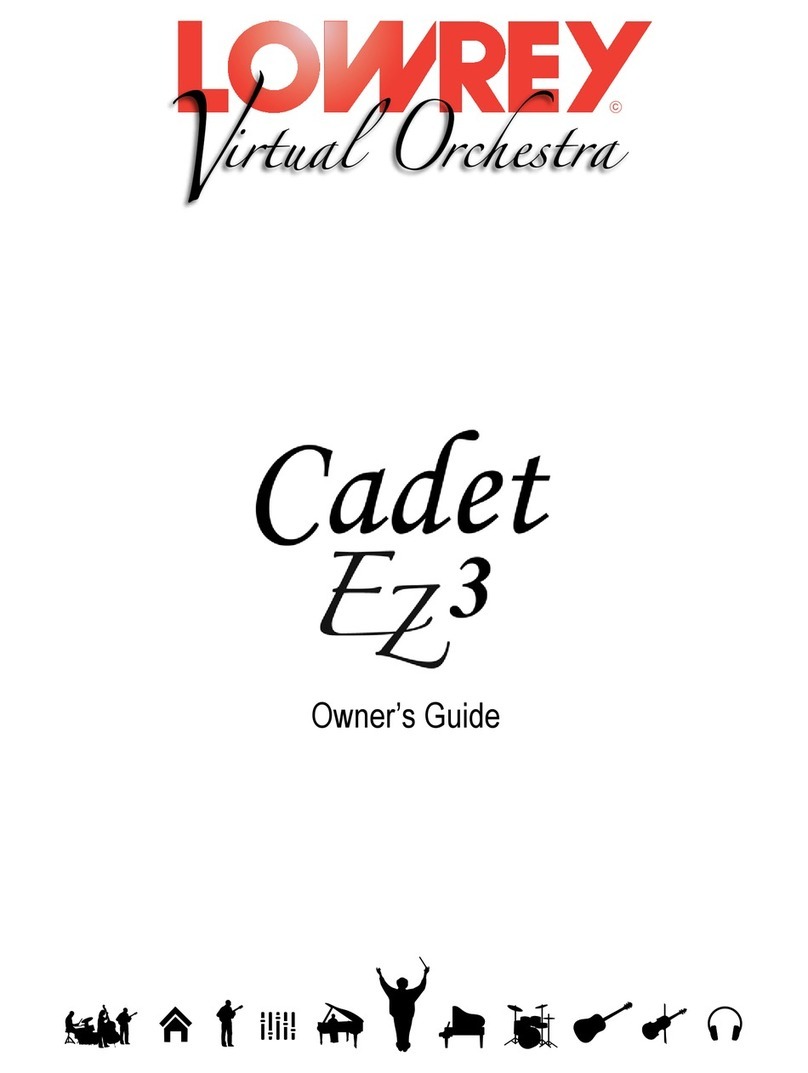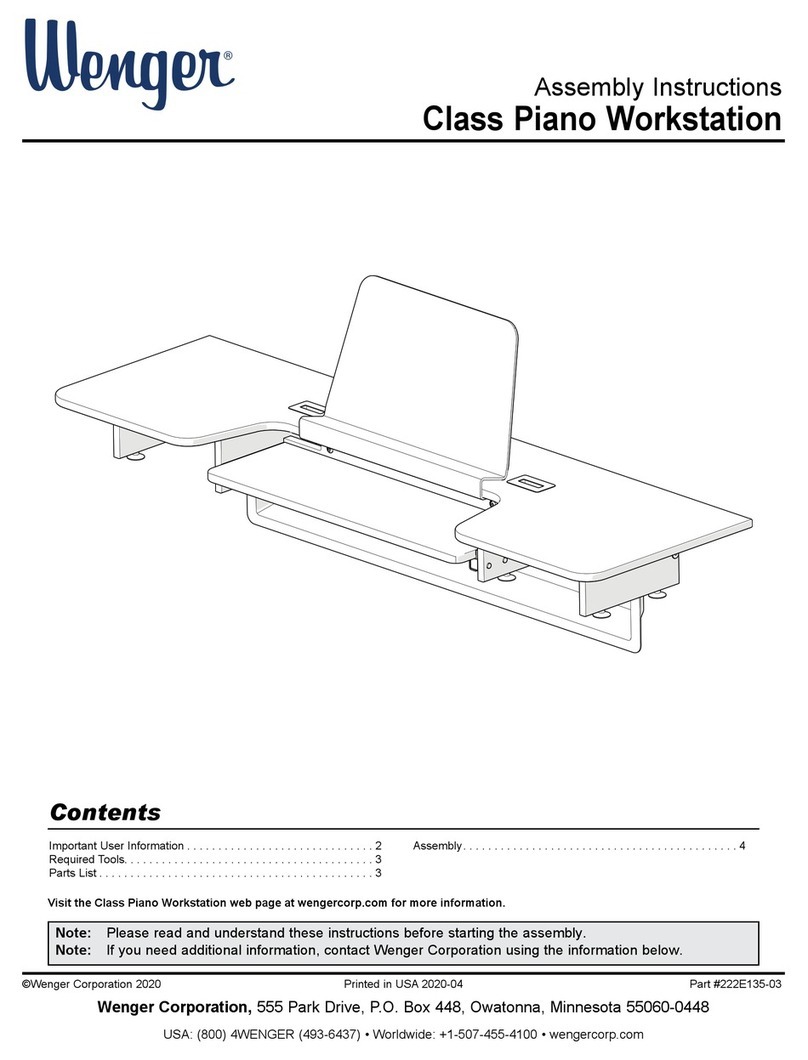Nino NINO951-MYO User manual

· Made out of Baltic Birch (Betula)
· Size 10 ¼” x 14” x 10 ¼”
· Steel snare wires
CAJON BAUSATZ
CAJON KIT
CAJON KIT DE MONTAJE
KIT DI MONTAGGIO CAJON
KIT DE MONTAGE DU CAJON
CAJON KÉSZLET
CAJONキット
卡宏套件
Make Your Own Cajon
ninopercussion.com

Bevor Sie mit der Montage beginnen, sollten Sie sich die Bauanleitung gründlich und komplett durchlesen, sowie alle benötigten
Werkzeuge bereitlegen und alle Bauteile sortieren. Weiterhin möchten wir darauf hinweisen, dass eine plane Arbeitsfläche die
folgenden Arbeitsschritte wesentlich erleichtern wird.
Lieferumfang
1 x Montageanleitung
12 x Seitenelement
21 x Bodenelement
31 x Deckenelement
41 x Rückwand
51 x Schlagfläche (mit NINO® Logo)
62 x Seitenleiste
71 x Boden- und 1 x Deckenleiste
81 x Befestigungsleiste für Snare
91 x Snare
10 4 x Gummifüße
11 15 x Schrauben 3 x 20 mm
(für Schlagfläche)
12 4 x Schrauben 4 x 15 mm
(für Gummifüße)
13 2 x Schrauben 3 x 12 mm
(für Snare)
Korpus verleimen
Beim ersten Arbeitsschritt werden die vier Korpus-Elemente zusammengesteckt
und verleimt. Den Leim bitte in die Nut und auf die äußere Leiste anbringen, siehe
Bild 1. Es empfiehlt sich, diese vier Elemente vor dem Verleimen kurz zusammen-
zustecken, um eventuelle Verwechslungen zu vermeiden. Um den nötigen Druck
für das Verleimen aufzubauen, werden die 600 mm Schraubzwingen oder die
beiden Spannbänder benötigt, siehe Bild 2. Es ist auf die Bündigkeit der Elemente
und auf den Winkel wie im Bild 2 zu achten. Überschüssiger Leim kann mit einem
feuchten Tuch entfernt werden. Der Leim sollte mindestens 120 Minuten trocknen,
bevor die Pressverspannung gelöst werden kann.
Leisten verleimen
Im nächsten Arbeitsschritt werden die vier Seitenleisten bündig an der Vorderseite
der Cajon verleimt (Bild 3). Hierzu werden die Schraubzwingen oder Leimzwin-
gen wie auf Bild 4 benötigt. Das Trocknen des Leimes wird ca. 60 bis 80 Minuten
betragen.
Reklamationen werden nur anerkannt, wenn mit der Montage des Bausatzes noch nicht begonnen wurde. Weiterhin übernimmt die Firma Roland Meinl Musikinstrumente
GmbH & Co. KG keine Haftung für Schäden, welche bei oder durch die Montage entstehen oder entstehen könnten. Irrtum und Änderungen vorbehalten. Version August 2013.
Benötigte Werkzeuge
› Holzleim
› 4 x Schraubzwingen 600 mm oder 2 x Spannbänder
› 2 bis 6 x kleine Schraubzwingen, alternativ Leimzwingen
› Akkuschrauber, Bohrmaschine oder Handbohrer
› Holzbohrer 3 mm, Senker
› Kreuzschlitzschraubendreher
› Verschieden gekörntes Schleifpapier
› Schleifklotz
› Bleistift, Winkel, Lineal
› Klebeband
› 2 x Montagehölzer, ca. 25 x 25 x 300 mm
› Multiplexplatte (oder ähnliches) mind. 310 x 455 mm
3 4
1 2
1
2 3
1 4 5
8
611
12 13
10
7
9
Make Your Own Cajon
CAJON BAUSATZ MONTAGEANLEITUNG
ninopercussion.com

Korpus verschleifen
Die Montage der Snare erfolgt, wie auf Bild 5 zu sehen, mittig auf der Hypotenuse
der Dreiecksleiste. Zur Montage werden die beiden Schrauben 3 x 12 mm benö-
tigt. Die Snare wie auf Bild 5 mit der Lötseite nach oben montieren. Nun werden
die Übergänge auf der Front und Rückseite des Korpus verschlien. Hier ist es
wichtig die Übergänge plan zu schleifen, um eine ideale Auflagefläche für die Front
und Rückwand zu schaen. Anschließend wird die Dreiecksleiste mit der bereits
vor-montierten Snare mittig, wie auf Bild 6 zu sehen, verklebt. Zum Fixieren wird
eine kleine Schraubzwinge oder Leimklemme benötigt. Die Trockenzeit des Leimes
beträgt hier ca. 60 Minuten.
Rückwand verleimen
Um ein ideales Verleimen der Rückwand zu garantieren, empfehlen wir eine
Multiplexplatte (oder etwas ähnliches), welche ca. je 10 bis 20 mm größer ist
als die Rückwand, zu verwenden. Die beiden Holzleisten (ca. 25 x 25 x 300 mm)
erleichtern die Verspannung mit den Schraubzwingen oder Spannbändern. Auf
der kompletten Rückseite des Korpus wird nun Leim aufgebracht. Achtung: Die
Rückseite ist die Seite ohne die bereits angebrachten Leisten. Die Rückwand wird
auf die Multiplexplatte gelegt und diese dann auf die zwei Leisten (Bild 7), welche
als Montagehilfe verwendet werden. Die Rückwand wird mit Hilfe eines Klebe-
bandes fixiert, sodass die sie an jeder Seite etwas Überstand zum Korpus hat.
Anschließend wird mit Hilfe der Schraubzwingen oder Spannbänder die Rückwand
angepresst, wie auf Bild 7 zu sehen ist. Nun nochmals die Positionierung der
Rückwand prüfen und den Leim für ca. 120 Minuten trocknen lassen.
Frontplatte verschrauben
Auf der Rückseite dieser Bauanleitung ist ein Plan für die 15 Bohrlöcher zum
Fixieren der Frontplatte abgebildet. Wir empfehlen diese genau auf der Frontplatte
abzumessen, siehe Bild 8. Die Bohrung der 15 Löcher erfolgt mit dem 3 mm Boh-
rer. Achtung: Um Schäden auf der Arbeitsfläche zu vermeiden, werden wiederholt
die Montageleisten benötigt. Mit Hilfe des Handsenkers oder eines 12 mm Stahl-
bohrers werden die Bohrlöcher nun so eingesenkt, dass die Schraubenköpfe nach
der Montage plan eingedreht sind. Die Frontplatte wird mit 15 Stück 3 x 20 mm
Schrauben auf dem Korpus fixiert (Bild 9). Achtung: Hier auch auf den gleichmäßi-
gen Überstand achten (wie auch bei der Rückwand) und mit Hilfe des Klebeban-
des vorfixieren. Verschraubt wird die Frontplatte am besten über die vier Ecken und
durch Vorbohren der Löcher mit dem 3 mm Holzbohrer, ca. 6 bis 8 mm tief.
Verschleifen, Montage der Gummifüße
Das Verschleifen der Überstände der Front- und Rückwand ist der nächste Arbeits-
schritt (Bild 10). Hierzu empfehlen wir anfangs ein grobes und dann ein feines
Schleifpapier zu verwenden. Mit dem feinen Schleifpapier wird dann auch der kom-
plette Korpus der Cajon verschlien. Für einen besseren Spiel- und Sitzkomfort
empfehlen wir alle Kanten so zu verschleifen, dass diese komfortabel abgerundet
sind. Die Befestigung der Gummifüße erfolgt mit den 4 x 15 mm Schrauben (Bild
11). Wir empfehlen für einen guten Stand der Cajon die Gummifüße mit einem
Abstand von ca. 25 mm nach innen von der Front- und Seitenplatte entfernt zu
befestigen. Das Anbringen erfolgt nach der Endbehandlung der Cajon.
Cajon Finish
Die Schablonen (auf der Kartonunterseite) liefern verschiedene Motive, die an den
schwarzen Umrandungen ausgeschnitten werden können (Bild 12). Die Kontur
kann dann mit Bleistift auf den Korpus der Cajon übertragen werden und nach
Belieben verziert bzw. ausgemalt werden (Bild 13).
5 6
8 9
7
12
10 11
13 14

Before starting to assemble your bongo cajon, you should carefully read through all the assembly instructions, gather together all
the requisite tools and organise all the components. It should also be noted that a good, level work surface will make the various
steps of the assembly process considerably easier.
Kit comprises
1 x assembly instructions
12 x side panels
21 x base panel
31 x top panel
41 x Rückwand
51 x playing surface (with NINO® Logo)
62 x side battens
71 x base & 1 x top batten
81 x securing batten for the snare
91 x snare
10 4 x rubber feet
11 15 x screws 3 x 20 mm
(for playing surface)
12 4 x screws 4 x 15 mm
(for rubber feet)
13 2 x screws 3 x 12 mm (for snare)
Gluing the body
The first step is to fit and glue together the four panels making up the main body
of the cajon. The glue should be applied within the groove and on the outer
batten, see Fig. 1. It is advisable to fit these four panels together briefly before
the adhesive is applied to ensure that they are joined in the right order. To create
the necessary pressure for adhesion, the 600 mm screw clamps or the two belt
clamps must be used, see Fig. 2. Make sure that the panels fit together flush and
at the correct angle, see Fig. 2. Any excess glue can be removed with a damp cloth.
The glue must be allowed to dry for at least 120 minutes before the compressive
force is released.glue must be allowed to dry for at least 120 minutes before the
compressive force is released.
Gluing the battens
The next step is to glue the four side battens on flush with the cajon‘s front surface
(Fig. 3). You will need the screw clamps or glue clamps at this point, see Fig. 4.
The glue must be left for around 60 to 80 minutes to dry.
Warranty claims will only be considered if the assembly process has not been started. Furthermore, Roland Meinl Musikinstrumente GmbH & Co. KG will not accept liability for
any damage incurred or possibly incurred in the course of or as a result of the assembly process. Subject to corrections and changes. Version dated August 2013.
Tools required
› Wood glue
› 4 x screw clamps 600 mm or 2 x belt clamps
› 2 to 6 x small screw clamps, or alternatively glue clamps
› Cordless screwdriver, drill or hand drill
› Wood drill bit 3 mm, countersink
› Cross-head screwdriver
› Sandpaper, various grades
› Sanding block
› Pencil, square, ruler
› Adhesive tape
› 2 x assembly blocks, approx. 25 x 25 x 300 mm
› Multiplex board (or similar) min. 310 x 455 mm
3 4
1 2
Make Your Own Cajon
CAJONKIT ASSEMBLY INSTRUCTIONS
ninopercussion.com
1
2 3
1 4 5
8
611
12 13
10
7
9

Sanding the body
The snare is fitted as shown in Fig. 5, in the middle of the hypotenuse of the
triangular batten. The snare should be mounted using the two 3 x 12 mm screws.
Mount the snare with its soldered side facing up as illustrated in Fig. 5. Next, the
surfaces for joining the front and rear panels of the cajon body should be sanded.
It is important that the joining surfaces should be sanded smooth in order to crea-
te a perfect seat for the front and rear panels. Next, the triangular batten, to which
the snare has already been attached, is glued centrally as shown in Fig. 6. A small
screw clamp or glue clamp will be needed here to secure the batten. For this step,
the glue must be allowed to dry for approx. 60 minutes.
Gluing the rear panel
To ensure that the rear panel will be securely bonded, we recommend the use of a
multiplex board or similar; this should be approximately 10 - 20 mm larger than the
rear panel. The two wooden battens (approx. 25 x 25 x 300 mm) make it easier to
apply the necessary pressure with the screw clamps or belt clamps. Glue is now
applied all over the rear side of the cajon body. Important: the rear side is the side
that has no battens already attached. The rear panel is laid down on the multiplex
board, which in turn is laid on the two battens, see Fig. 7, which are used as an as-
sembly aid. The rear panel is secured using adhesive tape with a slight overhang
beyond the cajon body on all four sides. Next, the screw clamps or belt clamps are
used to apply pressure to the rear panel as shown in Fig. 7. The positioning of the
rear panel should now be checked again, and then the glue should be allowed to
dry for approx. 120 minutes.
Screwing the front panel on
A diagram showing the positions of the 15 holes for securing the front panel can be
found overleaf. We recommend that the holes are measured out accurately on the
front panel, see Fig. 8. The 15 holes are drilled using the 3 mm drill bit. Important:
the assembly battens should be used when each hole is drilled to avoid damage
to the work surface. Using either the manual countersink or a 12 mm metal drill
bit, the holes should now be countersunk to allow the screw heads to end up flush
with the surface. The front panel is screwed to the body using 15 screws (3 x 20
mm) (Fig. 9). Important: again make sure that the overhang is even (as for the
rear panel) and use adhesive tape to initially secure the panel. The best way to
screw the front panel on is to use the four corners and pre-drill the holes with the 3
mm wood drill bit to a depth of approx. 6 to 8 mm.
Sanding, then fitting the rubber feet
The next step is to sand down the overhangs on the front and rear panels (Fig.
10). For this purpose, we recommend using coarse sandpaper first followed by
fine sandpaper. The fine sandpaper can then be used to sand the entire body of
the cajon. In order to make the instrument more comfortable to play and to sit on,
we recommend sanding all the edges until they are nicely rounded. The rubber
feet are secured with the 4 x 15 screws (Fig. 11). To ensure that the cajon will
stand securely on its feet, we recommend attaching the rubber feet approx. 25
mm inside the front and side panels. The feet are attached after the cajon has
been given its finish.
Cajon Finish
On the bottom of the box are several stencils to cut out (Fig. 12). These motifs can
be traced onto the cajon with a pencil to design your own custom look (Fig. 13).
5 6
8 9
7
12
10 11
13 14

Antes de comenzar con el montaje, debería leer atentamente estas instrucciones de montaje completas, preparar todas las
herramientas necesarias y ordenar todas las piezas. Además, recuerde que disponer de una superficie de trabajo llana facilita
notablemente la realización de los siguientes pasos de trabajo.
Suministro
1 instrucciones de montaje
12 elementos laterales
21 elemento de fondo
31 elemento de tapa
41 panel posterior
51 superficie de golpeo
(con el logo NINO®)
62 listones laterales
71 listón para el fondo y
1 listón para la tapa
81 listón de fijación para la bordonera
91 bordonera
10 4 pies de goma
11 15 tornillos 3 x 20 mm
(para la superficie de golpeo)
12 4 tornillos 4 x 15 mm
(para los pies de goma)
13 2 tornillos 3 x 12 mm
(para la bordonera)
Encolar el cuerpo
En el primer paso de trabajo se encajan y encolan los cuatro elementos del cuerpo.
Aplicar la cola en la ranura y en el listón exterior, véase la gura 1. Es recomenda-
ble encajar a modo de prueba estos cuatro elementos antes de encolarlos para
evitar posibles equivocaciones. Para poder generar la presión necesaria para el
encolado se necesitan los sargentos de 600 mm o ambas cintas de apriete, véase
la gura 2. Debe tenerse en cuenta que los elementos deben quedar enrasados y
con el ángulo adecuado según la gura 2. El exceso de cola puede retirarse con
un paño húmedo. La cola debería secar al menos 120 antes de aliviar la presión de
apriete.
Encolar los listones
En el siguiente paso de trabajo se encolan los cuatro listones laterales enrasados
con la parte frontal del cajón (gura 3). Para ello se necesitan los sargentos o los
prensatornillos como se muestra en la gura 4. La cola debe secar de 60 a 80
minutos.
Solo se aceptan reclamaciones antes de haber comenzado el montaje del juego. Además, la empresa Roland Meinl Musikinstrumente GmbH & Co. KG no acepta responsabilidad
ninguna por daños causados o que pudieran causarse durante ni debido al montaje. Sujeto a errores y modificaciones. Versión Agosto 2013.
Herramientas necesarias
› Cola blanca
› 4 sargentos de 600 mm o 2 cintas de apriete
› 2 a 6 sargentos pequeños, alternativamente prensatornillos
› Atornilladora a batería, máquina de taladrar o taladro manual
› Brocas para madera de 3 mm, Avellanador
› Destornillador de ranura de cruz
› Papel de lija de distintos granos
› Taco de lijar
› Lápiz, escuadra, regla
› Cinta adhesiva
› 2 listones de madera para el montaje, aprox. 25 x 25 x 300 mm
› Placa de contrachapado multicapa (o similar) de al menos 310 x 455 mm
3 4
1 2
Make Your Own Cajon
CAJONKITINSTRUCCIONESDEMONTAJE
ninopercussion.com
1
2 3
1 4 5
8
611
12 13
10
7
9

Suministro
1 instrucciones de montaje
12 elementos laterales
21 elemento de fondo
31 elemento de tapa
41 panel posterior
51 superficie de golpeo
(con el logo NINO®)
62 listones laterales
71 listón para el fondo y
1 listón para la tapa
81 listón de fijación para la bordonera
91 bordonera
10 4 pies de goma
11 15 tornillos 3 x 20 mm
(para la superficie de golpeo)
12 4 tornillos 4 x 15 mm
(para los pies de goma)
13 2 tornillos 3 x 12 mm
(para la bordonera)
Lijar el cuerpo
El montaje de la bordonera se realiza como se muestra en la gura 5, centrada en
la hipotenusa del listón triangular. Para el montaje se necesitan ambos tornillos
de 3 x 12 mm. La bordonera se monta como se muestra en la gura 5 con la parte
soldada hacia arriba. Ahora se lijan las transiciones de la parte frontal y posterior
del cuerpo. Es importante lijar las transiciones planas para conseguir una super-
ficie de apoyo ideal para los paneles frontal y posterior. A continuación, se encola
el listón triangular con la bordonera premontada centrado como se ve en la gura
6. Para fijarlo se necesita un sargento o un prensatornillo pequeño. El tiempo de
secado de la cola es de unos 60 minutos.
Encolar el panel posterior
Para garantizar un encolado ideal del panel posterior, recomendamos utilizar un
panel contrachapado multicapa (o un elemento similar) que debe ser 10 - 20 mm
mayor que el panel posterior. Ambos listones de madera (aprox. 25 x 25 x 300
mm) facilitan el apriete con los sargentos o las cintas de apriete. Se aplica cola a
toda la parte posterior del cuerpo. Atención: la parte posterior es la parte que no
lleva listones instalados. El panel posterior se coloca sobre el tablero multicapa y
este sobre los dos listones (gura 7), que sirven como ayuda de montaje. El panel
posterior se fija con ayuda de cinta adhesiva de manera que sobresalga por todos
los lados ligeramente del cuerpo. A continuación, el panel posterior se comprime
con ayuda de los sargentos o las cintas de apriete como se ve en la gura 7.
Comprobar de nuevo el posicionamiento del panel posterior y dejar secar la cola
durante aproximadamente 120 minutos.
Atornillar el panel frontal
En la última página hay un croquis con los 15 taladros para fijar panel frontal.
Recomendamos reproducirlo exactamente en el panel frontal, véase la gura 8.
Los 15 taladros se realizan con la broca de 3 mm. Atención: para evitar causar
daños en la superficie de trabajo, deben utilizarse repetidamente los listones de
montaje. Con ayuda del avellanador o una broca de acero de 12 mm se rebajan los
taladros de manera que las cabezas de los tornillos queden atornilladas a ras tras
el montaje. El panel frontal se fija con 15 tornillos 3 x 20 mm al cuerpo (gura 9).
Atención: para ello, asegurarse de que sobresale de forma homogénea (como el
panel posterior) y fijarlo con cinta adhesiva. Los mejor es atornillar el panel frontal
empezando por las cuatro esquinas y taladrando previamente con la broca de
madera de 3 mm hasta una profundidad de entre 6 y 8 mm.
Lijar y montar los pies de goma
El lijado de los salientes del panel frontal y el panel posterior es el siguiente paso
de trabajo (gura 10). Para ello, recomendamos empezar con un papel de lija de
grano grueso y acabar con uno de grano de fino. Con el papel de grano fino se
lija también el cuerpo del cajón completo. Para mejorar la comodidad de asiento
y a la hora de tocar, recomendamos lijar todos los cantos de manera que queden
redondeados. Los pies de goma se fijan con los tornillos de 4 x 15 mm (gura 11).
Para una buena estabilidad del cajón, recomendamos fijar los pies de goma a una
distancia de unos 25 mm hacia dentro respecto a los paneles frontal y laterales.
Se montan después de haber acabado el cajón.
Acabar el cajón
En la parte inferior de la caja hay varias plantillas para cortar (gura 12). Estos
motivos pueden ser calcados en el cajón con un lápiz para diseñar su propio estilo
personalizado (gura 13).
5 6
8 9
7
12
10 11
13 14

Prima di iniziare con il montaggio, si devono leggere accuratamente e completamente le istruzioni di costruzione e montaggio,
preparare tutti gli utensili necessari ed ordinare tutti i componenti. Inoltre desideriamo richiamare l'attenzione sul fatto che una
superficie di lavoro piana agevola notevolmente le fasi di lavoro.
Confezione
1 istruzioni di montaggio
12 elementi laterali
21 elemento di base
31 elemento di copertura
41 pannello posteriore
51 superficie di percussione
(con logo NINO®)
62 listelli laterali
71 listello di base e 1 listello di sotto
81 listello di rinforzo per la piattina
91 piattina
10 4 piedini di gomma
11 15 viti 3 x 20 mm
(per la superficie di percussione)
12 4 viti 4 x 15 mm
(per i piedini di gomma)
13 2 viti 3 x 12 mm (per la piattina)
Incollaggio della cassa
Con la prima fase di lavoro vengono innestati insieme e incollati i quattro elementi
che formano la cassa. Applicare la colla nella scanalatura e sul listello esterno,
vedere gura 1. Si consiglia di innestare brevemente insieme questi quattro
elementi prima dell'incollaggio, per evitare eventuali confusioni. Per creare la
necessaria pressione di incollaggio, si usano i morsetti a vite da 600 mm o i due
nastri di serraggio, vedere gura 2. Occorre prestare attenzione che gli elementi
siano bene a raso e formino un angolo retto come illustrato nella gura 2. La colla
in eccesso può essere rimossa con un panno umido. La colla deve asciugare per
almeno 120 minuti prima di rimuovere gli elementi di serraggio.
Incollaggio dei listelli
Nella successiva fase di lavoro vengono incollati i quattro listelli laterali a raso sulla
facciata anteriore del Cajón (gura 3). A questo proposito sono necessari i morset-
ti a vite o i morsetti da falegname come indicato nella gura 4. L'asciugatura della
colla richiede all'incirca da 60 a 80 minuti.
Saranno accettati reclami soltanto se non è ancora stato iniziato il montaggio del kit. Inoltre, la ditta Roland Meinl Musikinstrumente GmbH & Co KG non si assume alcuna respon-
sabilità per danni che si verificano o potrebbero verificarsi durante o a causa del montaggio. Con riserva di errori e modifiche. Versione agosto 2013.
Utensili necessari
› Colla da legno
› 4 morsetti a vite 600 mm o 2 nastri di serraggio
› Da 2 a 6 piccoli morsetti a vite, in alternativa morsetti da falegname
› Avvitatore a batteria, trapano o trapano a mano
› Punte da legno 3 mm, Allargatore
› Cacciavite a stella
› Carta abrasiva di diversa grana
› Blocchetto abrasivo
› Matita, squadra, riga
› Nastro adesivo
› 2 legni di montaggio, circa 25 x 25 x 300 mm
› Compensato multiplex (o simile) almeno 310 x 455 mm
3 4
1 2
Make Your Own Cajon
ISTRUZIONI DI MONTAGGIO CAJON
ninopercussion.com
1
2 3
1 4 5
8
611
12 13
10
7
9
tease

Carteggiatura della cassa
Il montaggio della piattina viene eseguito centralmente sull'ipotenusa del listello
triangolare, come illustrato nella gura 5. Per il montaggio sono necessarie le due
viti 3 x 12 mm. Montare la piattina come indicato nella gura 5, con il lato di bra-
satura verso l'alto. Ora vengono carteggiati i punti di passaggio sul lato anteriore e
posteriore della cassa. In questo punto è importante che i punti di passaggio siano
carteggiati in modo livellato, così da creare una superficie di appoggio ideale per il
pannello anteriore e posteriore. Successivamente incollare centralmente il listello
triangolare con la piattina già premontata, come illustrato nella gura 6. Per il fis-
saggio si utilizza un piccolo morsetto a vite o un morsetto da falegname. Il tempo
di asciugatura della colla è in questo caso di circa 60 minuti.
Incollaggio del pannello posteriore
Per garantire un incollaggio ideale del pannello posteriore, consigliamo di utilizzare
un compensato multiplex (o qualcosa di simile) che sia circa 10-20 mm più gran-
de del pannello posteriore. I due listelli di legno (ca. 25 x 25 x 300 mm) agevolano
il bloccaggio con i morsetti a vite o i nastri di serraggio. A questo punto si applica
la colla sull'intero lato posteriore della cassa. Attenzione: il lato posteriore è il lato
senza i listelli già applicati. Il pannello posteriore viene collocato sul compensato
multiplex e questi sono poi posti sui due listelli (gura 7) che vengono utilizzati
come aiuto nel montaggio. Fissare il pannello posteriore usando un nastro adesi-
vo, in maniera tale che il pannello posteriore abbia un po' di sporgenza su ogni lato
rispetto alla cassa. Successivamente, con l'aiuto dei morsetti a vite o dei nastri di
serraggio pressare il pannello posteriore, come illustrato nella gura 7. A questo
punto controllare ancora una volta il posizionamento del pannello posteriore e
lasciare asciugare la colla per circa 120 minuti.
Avvitamento del pannello anteriore
Sul retro è presente uno schema dei 15 fori per il fissaggio del pannello anterio-re.
Si consiglia di misurarli esattamente sul pannello anteriore, vedere gura 8.
L'esecuzione dei 15 fori è da eettuarsi con la punta da trapano da 3 mm. Atten-
zione: per evitare danni sulla superficie di lavoro sono più volte necessari i listelli
di montaggio. Con l'aiuto dell’allargatore manuale o di una punta di acciaio per tra-
pano da 12 mm, allargare i fori in maniera tale che dopo il montaggio le teste delle
viti risultino avvitate a raso. Fissare il pannello anteriore sulla cassa con 15 viti 3 x
20 mm (gura 9). Attenzione: anche qui prestare attenzione che la sporgenza sia
uniforme (al pari del pannello posteriore) ed eettuare un fissaggio preliminare
usando il nastro adesivo. La soluzione migliore è quella di avvitare il pannello
anteriore sui quattro angoli e con una pre-esecuzione dei fori con la punta da legno
da 3 mm, ad una profondità di circa 6 - 8 mm.
Carteggiatura, montaggio dei piedini di gomma
La fase di lavoro successiva è la carteggiatura delle sporgenze dei pannelli
anteriore e posteriore (gura 10). A questo scopo si consiglia di utilizzare inizi-
almente una carta a-brasiva grossolana e poi una fine. Con la carta abrasiva fine
carteggiare poi anche l'intera cassa del Cajón. Per un migliore comfort da seduti e
nell'utilizzo dello strumento, si consiglia di carteggiare tutti i bordi, in modo che ri-
sultino arrotondati e non diano fastidio. Eettuare il fissaggio dei piedini di gomma
con le viti da 4 x 15 mm (gura 11). Anché il Cajón sia adeguatamente stabile, si
consiglia di fissare i piedini di gomma ad una distanza di circa 25 mm dai pannelli
anteriore e laterali, verso l'interno. L'applicazione deve essere eettuata dopo il
trattamento finale del Cajón.
Finitura del Cajón
Sulla parte inferiore del cartone vi sono le sagome di diversi disegni che possono
essere ritagliati seguendo i contorni del bordo nero (gura 12). La sagoma così
ottenuta, appoggiata sul corpo del cajon, potrà essere trasferita seguendone i con-
torni a matita ed essere decorata, dipinta o personalizzata a piacere (gura 13).
5 6
8 9
7
12
10 11
13 14
tease

Avant de procéder au montage, il est conseillé de lire attentivement cette notice de montage dans son intégralité, de préparer tous
les outils nécessaires et de trier les diérentes pièces. Nous aimerions également souligner que les opérations suivantes seront
beaucoup plus faciles à réaliser sur une surface plane.
Matériel livré
1 notice de montage
12 plaques latérales
21 fond
31 dessus
41 dos
51 surface de frappe(avec logo NINO®)
62 tasseaux latéraux
71 tasseau pour le fond et
1 tasseau pour le dessus
81 tasseau de fixation pour le timbre
91 timbre
10 4 pieds en caoutchouc
11 15 vis 3 x 20 mm
(pour la surface de frappe)
12 4 vis 4 x 15 mm
(pour les pieds en caoutchouc)
13 2 vis 3 x 12 mm (pour le timbre)
Collage du corps
La première étape consiste à assembler et coller les quatre éléments constituant
le corps. Appliquer la colle dans la rainure et sur le bord extérieur, voir photo 1. Il
est conseillé de faire un essai d’assemblage de ces quatre éléments avant de les
coller pour éviter toute interversion éventuelle. Pour appliquer la pression néces-
saire pour le collage, utiliser les serre-joints à vis de 600 mm ou les deux sangles
de serrage, voir photo 2. Veiller à ce que les bords soient alignés et que l’angle soit
correct comme illustré sur la photo 2. La colle en excès peut être retirée avec un
chion humide. Laisser sécher la colle au moins 120 minutes avant de relâcher la
pression.
Collage des tasseaux
L’étape suivante consiste à coller les quatre tasseaux latéraux de niveau avec la
face avant du cajon (photo 3). Pour cela, utiliser les serre-joints à vis ou les pinces
serre-joints comme illustré sur la photo 4. Le séchage de la colle nécessite 60 à 80
minutes environ.
Les réclamations ne seront acceptées que si le montage du kit de montage n’a pas encore commencé. En outre, la société Roland Meinl Musikinstrumente GmbH & Co. KG décline
toute responsabilité pour les dommages survenus ou pouvant survenir lors du montage ou suite au montage. Sous réserve d’erreur et de modifications. Version août 2013.
Outillage nécessaire
› Colle à bois
› 4 serre-joints à vis 600 mm ou 2 sangles de serrage
› 2 à 6 petits serre-joints à vis ou pinces serre-joints
› Visseuse, perceuse ou chignole
› Mèches à bois de 3 mm, Fraise à lamer
› Tournevis cruciforme
› Papier abrasif de différents grains
› Cale à poncer
› Crayon, équerre, règle
› Ruban adhésif
› 2 barres d’aide au montage en bois, env. 25 x 25 x 300 mm
› Contreplaqué multiplis (ou équivalent) d’au moins 310 x 455 mm
3 4
1 2
Make Your Own Cajon
NOTICE DE MONTAGE DU CAJON
ninopercussion.com
1
2 3
1 4 5
8
611
12 13
10
7
9

Ponçage du corps
Le timbre se monte comme illustré sur la photo 5, c’est-à-dire au milieu de
l’hypoténuse du tasseau triangulaire. Le timbre s’installe avec le côté à braser ori-
enté vers le haut, comme illustré sur la photo 5, et est fixé à l’aide des deux vis 3 x
12 mm. Les jonctions avec la face avant et le dos du corps sont ensuite poncées.
Il est ici important de poncer les jonctions afin d‘obtenir une surface d‘appui idéale
pour la face avant et le dos. Il convient ensuite de coller au milieu le tasseau trian-
gulaire avec le timbre préinstallé, comme illustré sur la photo 6. Pour le serrage,
utiliser un petit serre-joint à vis ou une pince serre-joint. Le temps de séchage de
la colle s’élève ici à environ 60 minutes.
Collage du dos
Afin de garantir un collage idéal du dos, nous conseillons d’utiliser une plaque de
contreplaqué multiplis (ou quelque chose d’équivalent) qui soit environ 10 à
20 mm plus grande que le dos de chaque côté. Les deux barres de bois (approx.
25 x 25 x 300 mm) facilitent le serrage au moyen des serre-joints à vis ou des
sangles de serrage. Appliquer maintenant de la colle sur tout l‘arrière du corps.
Attention: l’arrière correspond au côté sans tasseaux déjà montés. Poser le dos sur
la plaque de contreplaqué multiplis et installer cette dernière sur les deux barres
servant d’aide au montage (photo 7). Le dos est fixé à l’aide de ruban adhésif :
il doit dépasser légèrement de chaque côté du corps. Mettre ensuite en place le
serrage à l’aide des serre-joints à vis ou des sangles de serrage, comme illustré
sur la photo 7. Vérifier une nouvelle fois le positionnement du dos, puis laisser la
colle sécher pendant environ 120minutes.
Vissage de la face avant
Un schéma se trouve au dos avec les 15 trous de perçage permettant de fixer la
face avant. Nous conseillons de mesurer exactement l’emplacement des trous sur
la face avant (voir photo 8). Le perçage des 15 trous se fait avec la mèche de 3
mm. Attention: pour éviter d’endommager la surface de travail, utiliser de nouveau
les barres de montage. Chambrer les trous de perçage à l’aide de la fraise à lamer
manuelle ou d’une mèche métallique de 12 mm de façon à ce que les têtes de vis
soient aeurantes une fois installées. Fixer la face avant au corps à l’aide de 15
vis 3 x 20 mm (photo 9). Attention: veiller ici aussi à ce que la face avant dépasse
de la même manière de tous les côtés (comme pour le dos) et la préfixer avec du
ruban adhésif. Le mieux est de visser la face avant par les quatre coins en préper-
çant des trous de 6 à 8 mm environ avec la mèche à bois de 3 mm.
Ponçage, montage des pieds en caoutchouc
L’étape suivante consiste à poncer les parties qui dépassent de la face avant et
du dos (photo 10). Nous conseillons pour cela de commencer avec un papier ab-
rasif grossier, puis de poursuivre avec un papier fin. Ce dernier servira également
à poncer en-suite l’ensemble du corps du cajon. Pour un meilleur confort de jeu et
d’assise, nous conseillons de poncer toutes les arêtes afin qu‘elles soient arron-
dies. Les pieds en caoutchouc se fixent à l’aide des vis 4 x 15 mm (photo 11). Pour
une bonne stabilité du cajon, nous conseillons de placer les pieds en caoutchouc à
environ 25 mm vers l’intérieur de la face avant et de la plaque latérale. Les installer
une fois la finition du cajon terminée.
Finition du cajon
Dans le fond de la boite plusieurs pochoirs á découper (photo 12). Ces motifs
peuvent être tracées sur le cajon avec un crayon afin de créer votre look person-
nalisé (photo 13).
5 6
8 9
7
12
10 11
13 14

Przed rozpoczęciem montażu Twojego cajona, powinieneś zapoznać się dokładnie z całą instrukcją montażu, skompletować potrzeb-
ne narzędzia i akcesoria montażowe. Warto też wiedzieć, że równa, pozioma powierzchnia, na której będziesz składał instrument,
ułatwi Ci zadanie.
Klejenie korpusu
Pierwszym krokiem jest dopasowanie i sklejenie czterech paneli, które składają
się na korpus cajona. Klej powinien być nakładany w bruzdach poszczegól-
nych płyt (rys. 1). Doradzamy, aby dopasować do siebie wszystkie płyty
przed rozpoczęciem klejenia, aby upewnić się, że będą prawidłowo złożone.
Aby zapewnić właściwy docisk płyt podczas klejenia, należy użyć docisków
śrubowych lub pasków dociskowych (rys. 2). Upewnij się, że panele są do siebie
dopasowane i że jest między nimi kąt prosty (rys. 2). Nadwyżki kleju można
usunąć ściereczką. Klej musi schnąć przez co najmniej 2 godziny, zanim dociski
zostaną zdjęte.
Klejenie listew
Następny krok to przyklejenie czterech bocznych listew dokładnie na krawędzi
przedniej cajona (rys. 3). W tym miejscu, przydadzą Ci się dociski śrubowe lub
klejowe (rys. 4) Klej musi schnąć przez ok. 60 do 80 minut.
3 4
1 2
Make Your Own Cajon
CAJONKITINSTRUKCJAMONTAŻU
ninopercussion.com
Zestaw zawiera
1 x instrukcja montażu
12 x panel boczny
21 x panel spodni
31 x panel górny
41 x panel tylny
51 x płyta czołowa (z logo NINO®)
62 x boczna listwa
71 x dolna i 1 x górna listwa
81 x listwa zabezpieczająca
do sprężyn
91 x sprężyna
10 4 x gumowe nóżki
11 15 x śruby 3 x 20 mm
(do płyty czołowej)
12 4 x śruby 4 x 15 mm
(do gumowych nóżek)
13 2 x śruby 3 x 12 mm (do sprężyn)
Reklamacje będą rozpatrywane wyłącznie przed rozpoczęciem montażu. Roland Meinl Musikinstrumente GmbH & Co. KG nie odpowiada za szkody powstałe w trakcie procesu
montażu. Niniejsze zapisy mogą być zmienione. Niniejsza wersja pochodzi z sierpień 2013.
Potrzebne narzędzia
› klej do drewna
› 4 x docisk śrubowy 600mm lub 2 paski dociskowe
› 2 do 6 x małych docisków śrubowych lub klejowych
› wkrętarka, wiertarka lub ręczna wiertarka
› wiertła do wiercenia w drewnie 3mm, frez
› śrubokręt krzyżakowy
› papier ścierny, różne grubości ziarna
› blok ścierny
› ołówek, cyrkiel, ekierka, miarka
› taśma klejąca
› 2 x drewniane listewki, ok. 25 x 25 x 300mm
› sklejka (lub coś podobnego) o wymiarach 310x455mm
1
2 3
1 4 5
8
611
12 13
10
7
9

Wygładzanie korpusu
Sprężyna powinna być zamontowana, jak widać na rys. 5 na środku
przeciwprostokątnej trójkątnej listewki i dodatkowo umocowana przy użyciu
dwóch śrub 3 x 12mm. Zamontuj ją lutowaną powierzchnią do góry, tak jak widać
na rys. 5. Następnie wygładź krawędzie korpusu, do których przymocujesz
panele przedni i tylny. Jest ważne, aby te krawędzie były gładkie i stanowiły
równą podstawę dla panelu przedniego i tylnego. Następnie przyklej listewkę z
przymocowaną do niej sprężyną centralnie, jak pokazano na rys. 6. Mały docisk
śrubowy lub klejowy będzie tu potrzebny do unieruchomienia listwy. Po tym
kroku, pozostaw klej do schnięcia na 60 minut.
Przyklejanie panelu tylnego
Aby upewnić się, że tylny panel będzie prawidłowo zamontowany, rekomendu-
jemy wykorzystanie w tym kroku sklejki lub podobnego materiału o wymiarach
o ok. 10 – 20 mm większych niż sam panel. Dwie drewniane listewki (ok. 25 x
25 x 300mm) ułatwią przyłożenie właściwej siły z wykorzystaniem docisków
śrubowych lub pasków. Klej należy nałożyć na całą powierzchnię tylnych krawędzi
korpusu cajona. Ważne: Tylna strona to ta, do której nie przymocowałeś wcześniej
listewek. Przyklejony tylny panel zabezpiecz taśmą klejącą na wszystkich czte-
rech stronach. Całość połóż na sklejce (tylnym panelem do dołu), a tę na dwóch
listewkach. (rys. 7), które wykorzystujesz jako pomoc montażową. Następnie
załóż dociski śrubowe lub paski dociskowe, jak pokazano na rys. 7. Teraz ponow-
nie sprawdź, czy w trakcie wykonywania tych operacji tylny panel nie przesunął
się. Jeśli wszystko jest w porządku, pozwól klejowi schnąć przez ok. 120 minut.
Przykręcanie panelu przedniego
Diagram pokazujący rozmieszczenie 15 otworów na śruby montażowe przed-
niego panelu znajdziesz na odwrocie. Rekomendujemy aby otwory zostały
rozmieszczone dokładnie według tego diagramu (rys. 8) 15 otworów wywiercisz
z wykorzystaniem 3 mm wiertła. Ważne: przy wierceniu otworów w panelu,
umieść go na listwach, aby nie uszkodzić powierzchni, na której pracujesz.
Teraz używając ręcznego frezu lub po prostu 12mm wiertła, nawierć otwory
w płycie, w które schowają się główki śrub mocujących płytę – po montażu,
powierzchnia ma być gładka. Przykręć panel czołowy z wykorzystaniem 15 śrub
3 x 20mm (rys. 9). Ważne: Upewnij się, że płyta jest równo ułożona na korpusie
i na czas przykręcania, przymocuj ją do korpusu taśmą klejącą. Najlepiej zacząć
przykręcanie panelu od przykręcenia śrub na rogach i wywiercenia otworów na
śruby 3mm wiertłem na głębokość ok 6 – 8 mm.
Wygładzanie krawędzi i montaż gumowych nóżek
Następny krok to wygładzanie krawędzi przy przednim i tylnym panelu (rys. 10).
Do tego celu zalecamy papier ścierny o grubszych ziarnach. Dopiero w kolejnym
kroku wykorzystasz papier drobnoziarnisty. Papieru drobnoziarnistego możesz
też użyć do wygładzenia całej powierzchni cajona. Aby zwiększyć komfort gry i
siedzenia na cajonie, rekomendujemy wygładzenie wszystkich krawędzi aż do ich
zaokrąglenia. Gumowe nóżki należy przymocować śrubami 4 x 15mm (rys. 11).
Aby mieć pewność, że będą spełniać swoje zadanie, rekomendujemy zamontować
je w odległości 25mm od czołowego i bocznych paneli. Nóżki mocuje się po
wykończeniu cajona.
Wykończenie cajona
Z dolączonych do Cajona tekturowych szablonów można wyciąć różne wzory
(wzdlóż czarnych lini) (rys. 12). Kontury mogą być następnie przeniesione
ołówkiem na korpus Cajona i pomalowane wybranym kolorem (rys. 13).
5 6
8 9
7
12
10 11
13 14

Mielőtt a szereléshez hozzákezdene, alaposan olvassa végig az útmutatót! Készítse elő a szereléshez szükséges szerszámokat,
csoportosítsa az alkotórészeket! Keressen egy sima, lapos munkafelület, ami az alábbi munka- folyamatot jelentősen megkönnyíti.
A test enyvezése
Első lépésként a négy oldalfal összeillesztésére és enyvezésére kerül sor. Az
enyvet kenje a horonyba és a külső szegélyre (1.kép). Tanácsos a négy elemet
még az enyvezés előtt összeilleszteni, hogy az esetleges összecserélést kiküs-
zöböljük. Ahhoz, hogy a megfelelő nyomóhatást elérjük, a
600 mm-es csavarszorítóra vagy mindkét feszítő hevederre szükségünk lesz
(2.kép). Figyeljen az elemek közötti kapcsolatra és derékszögre (2. kép).
A felesleges enyvet egy nedves kendővel törölje le. Az enyvnek legalább két óráig
száradnia kell, mielőtt a nyomókötést eltávolítjuk.
Lécek enyvezése
Következő lépésként a négy darab lécet szorosan a cajon elején belülről a falvége-
khez ragasztjuk (3.kép).
A 4. képen látható módon a léceket a csavar- vagy enyvező szorítóval rögzítjük.
Az enyv száradása kb.60-80 percet vesz igénybe.
3 4
1 2
Make Your Own Cajon
CAJONSZERELÉSIÚTMUTATÓ
ninopercussion.com
Alkatrészek
1 x Szerelési útmutató
12 x oldalfal elemek
21 x aljzat elem
31 x tető elem
41 x hátfal elem
51 x előlap (NINO® logóval)
62 x oldalléc
71 x aljzatléc és 1 x tetőléc
81 x sodrony rögzítő léc
91 x sodrony
10 4 x gumiláb
11 15 x csavar 3x20mm (falakhoz)
12 4 x csavar 4x15mm (gumilábakhoz)
13 2 x csavar 3x12mm (sodronyhoz)
Termékünkkel kapcsolatos reklamációt csak abban az esetben tudunk elfogadni, ha az összeszereléshez még nem fogott hozzá. Továbbá a Roland Meinl Musikinstrumente GmbH & Co. KG
nem vállal felelősséget azokért az esetleges károkért, melyek a szerelés folyamán keletkeztek vagy keletkezhettek. A termékre vonatkozó változtatás jogát fenntartjuk. 2013 augusztus.
Szükséges szerszámok
› faenyv
› 4 x csavarszorító 600mm, vagy 2 x feszítő heveder
› 2 – 6 x kis csavarszorító, vagy enyvező szorító
› akkus csavarhúzó, fúrógép vagy kézi fúró
› fafúró 3mm, nehezék
› csillagfejű csavarhúzó
› különböző finomságú csiszolópapír
› csiszolófa
› ceruza, szögmérő, vonalzó
› ragasztószalag
› 2 x fadarab kb.25x25x300 mm
› farost lemez vagy hasonló min. 310x455 mm
1
2 3
1 4 5
8
611
12 13
10
7
9

Sodrony felszerelése
A sodronyt a háromszög alapú hasáb átfogójának közepén szereljük fel (5.kép). A
szereléshez szükségünk van a két darab 3x12 mm-es csavarra.
A sodronyt a forrasztott oldalával felfelé rögzítjük. A test első és hátsó oldalán a
találkozásokat összecsiszoljuk, egy szintbe hozzuk, hogy az előlap és a hátsófal
később tökéletesen simuljon fel. Végül a sodronnyal ellátott rudacskát, a 6.képen
látható módon, középre helyezve felragasztjuk. A rögzítéshez a kis csavarszorítót
vagy enyvező szorítót használjuk. Az enyv kb. 1 óra alatt szárad meg.
Hátfal ragasztása
Ahhoz, hogy a hátfal ragasztása biztosan sikerüljön, javasoljuk, hogy egy farost-
lemezt, vagy más falemezt használjon. A lemeznek a hátfalnál minden irányban
kb.10-20 mm-el nagyobbnak kell lennie. A két kb.25x25x300 mm nagyságú
fadarab a csavarszorító vagy feszítő hevederek erejét eloszlatja. A test oldalainak
hátsó fali részeit (a lécek nélküli oldalt ) enyvvel bekenjük. Helyezze a hátfalat a
farost lemezre, majd azt a két fadarabra.
A hátfalat egy ragasztószalaggal fixáljuk, majd a csavarszorítóval vagy feszítő
hevederrel összeszorítjuk, (7.kép).
Ellenőrizze még egyszer a hátfal helyzetét, hagyja az enyvet kb 120 percig
száradni.
Előlap felszerelése
A Szerelési útmutató hátoldalán megtalálja az előlap rögzítéséhez szükséges 15
db furat elhelyezkedését. Javasoljuk, hogy ezeket pontosan mérje át az előlapra
(8.kép). A 15 db lyukat a 3mm-es fúróval fúrjuk ki, 6-8 mm mélyen. Annak érdeké-
ben, nehogy kárt tegyünk az előlapban, újra szükségünk lesz a fadarabokra. Egy
12mm-es fémfúró segítségével a furatokat úgy süllyesztjük be, hogy a csavarfejek
a becsavarás után az előlappal egy szintbe kerüljenek. A csavarozást a négy sa-
roknál kezdve az előlapot a 15 db 3x20mm-es csavarral a tesre rögzítjük (9.kép).
Figyelem: a hátfalhoz hasonlóan itt is ügyelni kell az egyenletes, sima átmenetek-
re, valamint javasolt az előrögzítést ragasztószalaggal elvégezni.
Csiszolás, gumilábak felszerelése
A következő feladat az elő- és hátfal tökéletes lecsiszolása (10.kép). Kezdetben
egy durvább, majd később egy finom csiszolópapírt használjon. A finom pórusú
csiszolópapírral végül az egész cajon testét simára csiszoljuk. A kényelmes játék
és ülés érdekében javasoljuk, hogy a széleket kissé kerekítve csiszolja le. A gumi-
lábakat négy darab 15mm-es csavarral rögzítjük (11.kép). Ahhoz, hogy a cajon
stabilan álljon, a gumilábakat az elő- és oldallaptól befelé 25 mm-es távolságra
helyezzük fel. Ugyanígy járjunk el a hátlapnál is. A lábakat a cajonon végzett utolsó
kezelési munkálatok után javasolt csak felszerelni.
Cajon Finish
A sablonokon (a karton alsó oldalán) különböző motívumok találhatók, melyeket
a fekete jelölés mentén lehet kivágni (12.kép). A körvonal mentén a motívum,
ceruzával a cajon testére rajzolható majd tetszés szerint díszíthető, kifesthető
(13.kép).
5 6
8 9
7
12
10 11
13 14

組立を始める前にこの組立説明書を最後までしっかりと読み、必要な工具を用意し、すべての組立部分を分類してください。平らな場所で作業をす
ることにより、以 下 の 作 業 がし や すくなります。
梱包内容
組立説明書 一部
1側板 2枚
2底板 1枚
3天板 1枚
4裏板 1枚
5打面板 1枚 (NINOのロゴつき)
6サイドバンド 2本
7底バンド、天バンド 各1本
8響線部品固定材 1本
9響線部品 1個
10 脚ゴム 4個
11 打面用ネジ 3 x 20 mm 15本
12 脚ゴム用ネジ 4 x 15 mm 4本
13 響線用ネジ 3 x 12 mm 2本
返品・交換はキットの組立前に限り可能です。また、組立作業によって生じた怪我・損害などに関してRoland Meinl Musikinstrumente GmbH & Co. KG は一切責任を負いかねますので
ご注意ください。 この説明書の内容は予告なく変更されることがあります。2013年8月版 。
3 4
1 2
Make Your Own Cajon
CAJONキット 組立説明書
ninopercussion.com
1
2 3
1 4 5
8
611
12 13
10
7
9
必要な工具
› 木材用接着剤
› クランプ 600 mm 4本、またはベルトストラップ 2本
› 小型クランプまたは接着用クランプ 2~6本
› コードレス・スクリュードライバ ー 、電 気ドリル 、また はハ ンドドリル
› 木工用ドリル 3 mm 、 下穴用錐
› プラスドライバー
› 紙やすり
› 紙やすりブロック
› 鉛筆、L型万能定規、定規
› 接着テープ
› 組立用木材 約25 x 25 x 300 mm
› 合板材(または同様のもの)、少なくとも310 x 455 mm
本体の接着
最初に外枠となる4枚の板を組み立てて、接着します。接着剤は図1のように外側の溝
に塗ります。板の取り違えを防ぐために、接着前に一度組み合わせて確認することをお
薦めします。確実に接着させるために、クランプ(600 mm)または2本のベルトストラ
ップを使用します (図2参照)。角に注意して、図2のように板の端と端を合わせてくださ
い。はみ出た接着剤は、湿らせた布で拭き取ってください。固定用のクランプ、または
ベルトで固定したまま、接着剤を少なくとも120分間は乾燥させてください。
当て木の接着
次にCajonの前面に4本の当て木を接着します。ここでは図4のように小型クランプま
たは接着用クランプを使用します。接着剤の乾燥時間は60分~80分間です。

5 6
8 9
7
12
10 11
13 14
本 体 の や すりが け
図5のように響線を三角柱側面の中央に取り付けます。取り付けるには、二つのネジ
3 x 12 mm が必要です。響線を図5のようにはんだ付けした面を上に向けて取り付
けます。本体の正面と裏面のつなぎ目のやすりがけをします。
このとき、打面が理想的な面になるよう、つなぎ目を平面になるようにやすりがけする
ことが大切です。響線を取り付けた三角柱を図6のように接着します。接着するには小
型クランプまたは接着用クランプを使用します。接着剤の乾燥時間は約60分間です。
裏板の接着
確実に裏板を接着するには、裏板よりも大きい10 ~20 mm の合板材を使用すること
をお薦めします。両方の木材 (約 25 x 25 x 300 mm) を使用すると、クランプやベルトス
トラップで容易にクランプすることができます。本体の裏面全体に接着剤を塗ります。
注意:裏面は当て木が取り付けられていない面です。裏面に合板材を置き、これらを図
6のように組立用木材の上に置きます。裏面は両側が本体よりもわずかにはみ出るよう
に接着テープで固定します。最後に、図7のようにクランプまたはベルトストラップで裏
面を固定します。もう一度裏面を確認し、約120分間接着剤を乾燥させます。
正面の固定
この組立説明書の裏の図で正面板を固定する15箇所の穴の位置を確認してください。
図7のように正面板の寸法を正確に測ってください。15個の下穴は3mm のドリルで開
けます。注意:作業場所を傷つけないために、再び取付材を使用してください。
下穴用錐または12 mm の鋼ドリルを使用し、組立図に従ってネジ頭を締められるよう
に下穴を開けます。正面板を本体に固定するには3 x 20 mm のネジを15個使用しま
す。注意:ここでも背面と同じように、両側が同じくらい出るように接着テープで固定し
ます。3 mmの木工ドリルで約6~8 mmの下穴を開け、 正面板を四隅で固定します。
やすりがけとゴム脚の取り付け
正面板と背板のはみ出した部分をやすりがけします。やすりがけにはまず、粗い紙やす
りを使用してから細かい紙やすりを使用することをお薦めします。細かいやすりを使用
して、Cajonの本体全体をやすりがけします。
楽器が演奏しやすいように、すべての角が丸くなるようにやすりがけすることをお薦め
します。ゴム脚は 4 x 15 mm のネジで固定します。Cajonが安定するように、ゴム脚は
正面板、背面板のそれぞれ25 mm 内側に取り付けることをお薦めします。ゴム脚は
Cajon の最終仕上げをしてから取り付けてください。
Cajon の仕上げ
セットには、ステンシル型が含まれています。鉛筆でこれらの型をカホンにトレースする
などして、世界にたった一つのカホンをデザインすることができます。

在开始安装之前,请认真阅读安装说明书,准备好全部所需工具并对各部件进行分类。此外,请在平整的工作面上进行安装,以方便实施下
述操作步骤。
供货范围
1 安装说明书
12 侧板
21 底板
31 顶板
41 背板
51 敲击板 (印有 NINO 标志)
62 侧板条
71 底板条,1 顶板条
81 响弦固定板条
91 响弦
10 4 橡胶脚垫
11 15 螺丝(3 x 20 mm,固定敲击板)
12 4 螺丝 (4 x 15 mm,固定橡胶脚垫)
13 2 螺丝 (3 x 12 mm,固定响弦)
我们仅接受针对尚未开始安装的卡宏套件的索赔要求。此外,对于安装时产生的损失,Roland Meinl Musikinstrumente GmbH & Co. KG 公司不承担责任。
保留修正错误及实施更改的权利。版本:2013年8月。
3 4
1 2
Make Your Own Cajon
卡宏套件安装说明书
ninopercussion.com
1
2 3
1 4 5
8
611
12 13
10
7
9
所需工具
› 木材粘合胶水
› 4 活动夹钳(600 mm)或 2 紧固带
› 2 - 6 小型活动夹钳,或者夹钳
› 电动螺丝刀,钻孔机或手摇钻
› 木钻子(3 mm), 扩孔钻
› 十字螺丝刀
› 粗砂纸及细砂纸
› 磨块
› 铅笔,角尺,直尺
› 胶带
› 2 安装辅助木条,尺寸约为 25 x 25 x 300 mm
› 复合板(或类似物),最小尺寸为 310 x 455 mm
粘合共鸣箱
第一步:拼插并粘合构成共鸣箱的四块板。向槽中以及外侧板条上涂抹胶水,参见
图 1。建议在涂抹胶水前先将四块板拼插起来一次,以免发生混淆。为达到所需粘
合压力,需使用 600 mm 的活动夹钳或紧固带进行固定(参见图 2)。操作时,注
意确保板的齐平和垂直性,如图 2 所示。用湿布擦掉多余的胶水。使胶水晾干 120
分钟以上,然后松开活动夹钳或紧固带。
粘合板条
第二步:将四根板条齐平地粘合至卡宏正面。操作时需要使用活动夹钳或夹钳,如
图 4 所示。涂抹的胶水需晾干 60 至 80 分钟。

5 6
8 9
7
12
10 11
13 14
打磨共鸣箱
如图 5 所示,将响弦安装至三角形板条的斜面上。拧上两个 3 x 12 mm 螺丝。安
装时,使响弦的焊接面朝上,如图 5 所示。现在,对共鸣箱正面及背面的接合处进
行打磨。为在正面及背面形成理想的支撑面,需将接合处打磨平整,这一点至关重
要。然后,将装好响弦的三角形板条粘合至中央位置,如图 6 所示。操作时需使用
小型活动夹钳或夹钳进行固定。胶水的晾干时间为约 60 分钟。
粘合背板
为使背板得到理想的粘合效果,建议使用比背板大 10 - 20 mm 的复合板(或类似
物)进行辅助。借助于两根安装辅助木条(约 25 x 25 x 300 mm),可以方便地使
用活动夹钳或紧固带进行固定。现在,向共鸣箱的整个背面涂抹胶水。注意:背面
是未安装板条的那一面。将背板置于复合板上,然后将复合板置于两根安装辅助木
条上(参见图 7)。用胶带固定背板,使背板在每一边上都有超出共鸣箱的余量。
然后,用活动夹钳或紧固带压紧背板,如图 7 所示。现在,再次通过检查确保背板
位置正确,然后使胶水晾干约 120 分钟。
拧上前板
在本说明书背面的图纸中,标明了用于固定前板(敲击板)的 15 个孔的位置。建
议您依照图纸先在前板上准确标出孔位,如图 8 所示。然后,用 3 mm 的钻头钻
孔。注意:为避免工作面损坏,需再次使用安装辅助木条。
用手摇扩孔钻或 12 mm 的钢钻进行扩孔,确保螺丝被拧入后螺丝头沉在表面之下。
通过 15 个 3 x 20 mm 的螺丝将前板固定在共鸣箱上。注意:请确保前板在每一边
上都均匀地超过共鸣箱(与背板一样),然后用胶带固定。在给前板拧螺丝时,建
议先操作四个角:用 3 mm 的木钻子钻出深约 6 至 8 mm 的孔,以便拧入螺丝。
打磨,安装橡胶脚垫
接下来,磨去前板和背板上的余量。建议先用粗砂纸粗磨,后用细砂纸精磨。之
后,用细砂纸打磨卡宏的整个箱体。为使您演奏和坐在卡宏上时更加舒适,建议打
磨全部棱边。橡胶脚垫通过 4 x 15 mm 的螺丝进行固定。为确保卡宏平稳,建议将
橡胶脚垫安装在距离前板和侧板边缘约 25 mm 的位置上。当卡宏的其它安装作业完
成之后,再安装橡胶脚垫。
整饰卡宏
在箱子的最底端有现成的图案模板,可供小朋友裁剪出来。这些图案可用铅笔在卡
宏鼓上勾出轮廓,然后绘制出您自己定制的外观。

15mm
58mm
260mm
17mm
21mm
21mm21mm
15mm
17mm
21mm
370mm
82mm82mm
82mm82mm
58mm
57mm 57mm
NINO® Percussion •Roland Meinl Musikinstrumente GmbH & Co. KG • Musik-Meinl-Str. 1 • 91468 Gutenstetten • Germany
Model: NINO951-MYO
Table of contents
Languages:
